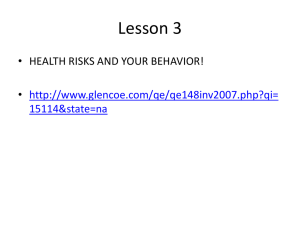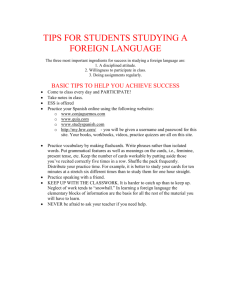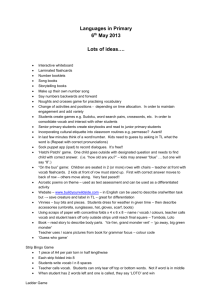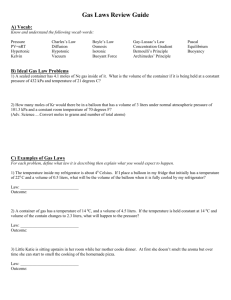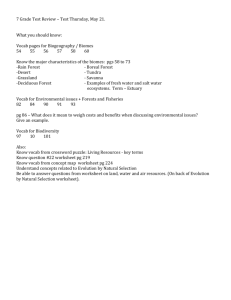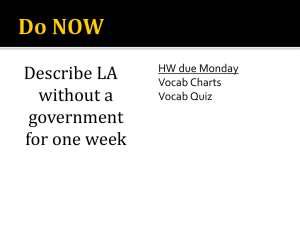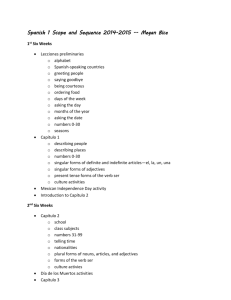Capítulo 3A pp
advertisement
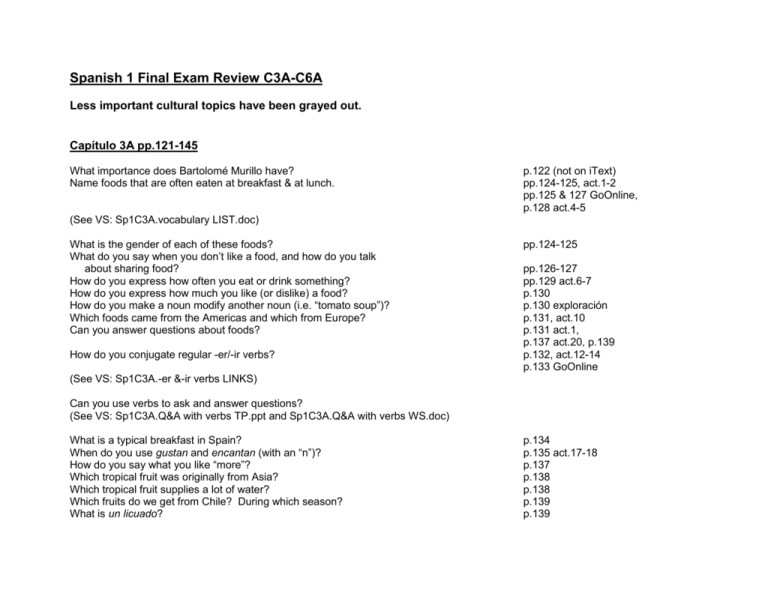
Spanish 1 Final Exam Review C3A-C6A Less important cultural topics have been grayed out. Capítulo 3A pp.121-145 What importance does Bartolomé Murillo have? Name foods that are often eaten at breakfast & at lunch. p.122 (not on iText) pp.124-125, act.1-2 pp.125 & 127 GoOnline, p.128 act.4-5 (See VS: Sp1C3A.vocabulary LIST.doc) What is the gender of each of these foods? What do you say when you don’t like a food, and how do you talk about sharing food? How do you express how often you eat or drink something? How do you express how much you like (or dislike) a food? How do you make a noun modify another noun (i.e. “tomato soup”)? Which foods came from the Americas and which from Europe? Can you answer questions about foods? How do you conjugate regular -er/-ir verbs? pp.124-125 pp.126-127 pp.129 act.6-7 p.130 p.130 exploración p.131, act.10 p.131 act.1, p.137 act.20, p.139 p.132, act.12-14 p.133 GoOnline (See VS: Sp1C3A.-er &-ir verbs LINKS) Can you use verbs to ask and answer questions? (See VS: Sp1C3A.Q&A with verbs TP.ppt and Sp1C3A.Q&A with verbs WS.doc) What is a typical breakfast in Spain? When do you use gustan and encantan (with an “n”)? How do you say what you like “more”? Which tropical fruit was originally from Asia? Which tropical fruit supplies a lot of water? Which fruits do we get from Chile? During which season? What is un licuado? p.134 p.135 act.17-18 p.137 p.138 p.138 p.139 p.139 What are churros and what beverage goes with it? What are the countries of northern Latin America? What is the name of the world’s highest navigable body of water? Where did the Americas get their name? What mountaintop city was part of the Incan empire in Peru? Which country is one of the most important sources of oil for the US? p.143 What are the Galapagos islands named after? p.140 p.142 p.142 p.142 p.143 p.143 Do the cumulative review for Capítulo 3A using glossary & chapter review on p.144; use online flashcards to review vocab; do test preparation on p.145 and the GoOnline test preparation also on p.145. Don’t forget the Guided Practice, Vocab Practice, Sp1C3A.MYNOTES.ppt, and spelling practices on QUIA! Capítulo 3B pp.146- 169 Who is Diego Rivera? What was Tenochtitlán and el tianguis? Name foods and food catagories in the food pyramid. How do you express hunger, thirst, agreement, preferences, things you think and things you ought to do? How do you tell what time of day it is? How do you give advice and agree with someone? How does a “ll” sound different from a “l”? How do you make adjectives plural? What is La Tomatina? How do you conjugate the verb “ser”? (See VS: Sp1C3B.ser & pronouns.ppt) p.146 (not on iText) p.146 (not on iText) pp.148-149, act.1-2 pp.149 & 151 GoOnline, p.152 act.4-5 pp.148-151, pp.153 act.6-7 p.154 p.154 p.155 p.156, act.12-13 p.156 p.158, act.15-18 p.159 GoOnline How do adjectives have to agree when using ser? (See VS: Sp1C3B.plurals WS.doc; Sp1C3B.ser & adjectives WS.doc; Sp1C3B.ser & adj. LINKS.doc) What are los mercados? Where did the names of foods come from? p.160 p.160 Can you answer questions about food and exercise? Can you read and answer questions about sports and nutrition? What are yerbabuena and other herbal remedies? Where do a large proportion of South American people live? What are las cataratas de Iguazú? What is the Cerro Aconcagua and where is it? Did any indigenous groups survive? How did Spain’s introduction of livestock transform the region? What is one of the most cosmopolitan cities in the world? p.161act.20 pp.162-163 p.164 p.165 p.165 p.166 p.167 p.167 p.167 Do the cumulative review for Capítulo 3B using glossary & chapter review on p.168; use online flashcards to review vocab; do test preparation on p.169 and the GoOnline test preparation also on p.169. Don’t forget the Guided Practice, Vocab Practice, Sp1C3B.MYNOTES.ppt, and spelling practices on QUIA! Capítulo 4A pp.170-195 Who painted El Quitasol and what is it? p.171 (pic. not on iText) What are some places you go in your free time? pp.172-173, act.1-2 p.176 act.4-5, pp.173 & 175 GoOnline What is the difference between “libre” and “gratis” meaning free? (Refer to Food Lion posters) How do you talk about where you’re going, with whom and why? Can you understand when others are making plans? pp.172-173 p.175 Videohistoria act.3 How do you express “to the” when going to a place? What is the main square called and what is one famous one? (See picture in VS: Sp1C4.Plaza Morazan en Tegucigalpa) p.177 act.6 p.177 What are the origins of the days of the week? How do you say “on Monday” and “on Mondays” etc.? p.178 exploración p.178 act.8 Can you answer questions about where you are going? What is the conjugation of the verb ir? p.179 act.10 p.180, act.11-13 p.183 GoOnline When do you use “ir a” or “estar en”? (See VS: Sp1C4A.Ir & interrogatives TP.ppt) What do you know about sports clubs and gyms? What are the three rules of stress and accents? (See VS: Sp1C4A.rules of stress.ppt) p.181 p.183 What words do you use to ask questions? (See Quia - http://www.quia.com/jw/125107.html) What about movies in Hispanic countries? p.184, act.15-16 p.185 How do you ask questions? p.186 act.17-18, p.186 GoOnline (See VS: Sp1C4A.interrogatives LINKS.doc; Sp1C4A.forming Q's WS.doc; Sp1C4A.answering Q's WS.doc; Sp1C4A.interrogatives WS1-4, ) What is the capital of Puerto Rico? (Do you remember the history of how the county and capital got their current names?) What is the Parque de las Palomas? (See pictures in Sp1C4.Puerto Rico folder to find out) p.186 How is Puerto Rico a commonwealth (hint: what currency do they use)? What is El Morro and why was it built? p.187 p.187 When did Christopher Columbus visit San Juan? Who is buried in La Catedral de San Juan? p.187 p.187 What do you know about Andean music? p.189 What’s the oldest permanent settlement in the US? Who first settled a large section of what now belongs to the US? What is the Alamo known for? p.192 p.192 p.192 What languages is the Nahua language related to? What is characteristic about the architecture in New Orleans? What is the history of Fort Marion? p.192 p.193 p.193 Do the cumulative review for Capítulo 4A using glossary & chapter review on p.194; use online flashcards to review vocab; do test preparation on p.195 and the GoOnline test preparation also on p.195. Don’t forget the Guided Practice, Vocab Practice, Sp1C4B.MYNOTES.ppt, and spelling practices on QUIA! Capítulo 4B pp.196-219 What are some sports and other leisure events? How do you what you want, would like, can, have to, prefer? How do you tell how you feel? Can you understand and answer questions about sports that young people know how to play? Can you ask and tell what you know how to do? Can you tell if someone is accepting or refusing an invitation? Can you write a dialogue about an invitation? How do you express “at a time” during a particular time of day? Can you answer questions about your leisure activities? What would you see at the festival of La noche de los rábanos? How do you express the near future “going to do”? Can you read and answer questions about Zamoro’s dream? Can you read and understand the articles about two golf players? Who is Rebecca Lobo? What about extracurricular activities in Hispanic countries? What percent of people in the US are Hispanic? Who are Dr. Franklin Chang-Díaz and Dr. Ellen Ochoa? How does Spanish-speaking culture influence the US? In what US city is there heavy Puerto Rican influence? pp.198-199, act.1 pp.199 & 201 GoOnline pp.198-199 pp.198-199, act.2, p.203 act.7-8 p.175 VideoHistoria act.3 p.202 act.5 p.203 act.9 p.207 act.17 p.204 act.10-11 p.205 act.12, p.211 act.22 p.205 p.206, act.13-15 p.207 GoOnline p.209 pp.212-213 p.213 p.214 p.216 p.216 p.216 P.217 In what US city is there heavy Cuban influence? What is the name of a popular Cuban festival? What do the towns of Laredo, Texas and Tijuana, Mexico have in common? p.217 p.217 p.217 Do the cumulative review for Capítulo 4B using glossary & chapter review on p.218; use online flashcards to review vocab; do test preparation on p.219 and the GoOnline test preparation also on p.219. Don’t forget the Guided Practice, Vocab Practice, Sp1C4B.MYNOTES.ppt, and spelling practices on QUIA! Capítulo 5A pp.221-245 What artist is known for her paintings that show Mexican American family life in her native South Texas in the 1950’s? p.220 (not on iText) What are the Spanish words for the various family members? p.222, p.223 act.1 p.226 act.4 (See VS: Sp1C5A.family LINKS.doc, Sp1C5A.family WS.doc) How do you talk about age and older & younger brothers? What are words to talk about party decorations and activities? p.222 pp.222-225, act.2 p.226 act. How do you answer questions about your family? p.227 act.8, p229 act.11 What is the conjugation of the verb tener? p.228, p.228 act.9-10, p.230 act.14, GoOnline How do you use tener que to express “have to”? p.229 act.13 Who is La familia real? p.230 Who painted La familia de Carlos IV and why? p.230 What are the possessive adjectives and what do they agree with? p.232, p232 act.18, p.234 GoOnline (See VS: Sp1C5A.possessives.ppt folder; Sp1C5A.possessives LINKS.doc; Sp1C5A.possessives NOTES.ppt; Sp1C5A.possessives TP.ppt) What are diminutives and how are they formed? Who is the famous Mexican muralist? p.235 p.237 What is La molendera about and what is a metate? What can you tell about the tradition of the quinceañera? What is papel picado and how do you make it? p.237 p.238-239 p.240 Do the cumulative review for Capítulo 5A using glossary & chapter review on p.244; use online flashcards to review vocab; do test preparation on p.245 and the GoOnline test preparation also on p.245. Don’t forget the Guided Practice, Vocab Practice, Sp1C5A.MYNOTES.ppt, and spelling practices on QUIA! Capítulo 5B pp.246-269 What do you know about the Hispanic role extended families? How do you describe people’s physical characteristics? What are the words for table settinigs? How do you ask for things at a restaurant? What are some other uses of tener? How might Hispanics get a server’s attention, and should we? How do you change adjectives into their “extremely” form? What is the conjugation of the verb venir? How do you talk about coming to a party & what you are bringing? When should you use ser and when should you use estar? p.246 (not on iText) p.248, p.249 act.1 p.249, p.249 act.2, GoOnline pp.250-251 p.253 act.7 p.253 p.255 p.257 p.257 act.14 p.258, p.258 act.15, p.259 act.16, p.261 GoOnline (See VS: Sp1C5B.ser vs. estar LINKS.doc; Sp1C5B.ser y estar TP.ppt) What is un menú del día and what else is it called? Where is Santa Fe and what else do you know about it? What is characteristic about Hispanic mealtimes? p.260 pp.262-263 p.264 Do the cumulative review for Capítulo 5B using glossary & chapter review on p.268; use online flashcards to review vocab; do test preparation on p.269 and the GoOnline test preparation also on p.269. Don’t forget the Guided Practice, Vocab Practice, Sp1C5B.MYNOTES.ppt, and spelling practices on QUIA! Capítulo 6A pp.270-295 Who is Salvador Dalí and where did he live? What are the items in a bedroom? What are the Spanish names for colors? How can you describe things in a room? What are some opposites of descriptive words? How do you make comparisons in Spanish? How do you form the superlative in Spanish? How do you talk about the best and the worst? What are the conjugations of the verbs poder and dormir? How do you talk about what you CAN do? How can roots of words help you to learn other words? Can you read and answer questions about a messy room? Do Hispanic countries have the same electronic equipment as we do? What are las luminarias and how do you make them? p.270 (not on iText) pp.272-273, p.273 act.1 p.2473, p.273 act.2, GoOnline, p.282 act.17-18 Videohistoria pp.274-275 p.276 act.4 p.278, p.279 GoOnline p.280, p.283 GoOnline p.280 act.14 p.284, p.284 act.22, p.287 GoOnline pp.284-285 act.23-25 p.286 pp.288-289 p.289 p.290 Do the cumulative review for Capítulo 6A using glossary & chapter review on p.294; use online flashcards to review vocab; do test preparation on p.295 and the GoOnline test preparation also on p.295. Don’t forget the Guided Practice, Vocab Practice, and spelling practices on QUIA! Useful Websites for Spanish review and practice: **Sra. Faw's Quia review links http://www.quia.com/pages/faw.html *Prentice Hall online textbook http://www.phschool.com/ *Realidades PPTs online (some have errors) http://www.ba.k12.ok.us/schools/nihs1/powerpoint/pptpres.htm BBC Spanish online http://www.bbc.co.uk/languages/spanish/ Colby University online practice http://www.colby.edu/~bknelson/exercises/ PHSchool Web codes http://www.phschool.com/webcodes10/index.cfm?fuseaction=home.gotoWebCode&wcprefix=jck&wcsuffix=0001 SpanishAbout.com http://spanish.about.com/cs/forbeginners/a/beg_lessons.htm SpanishClassOnline.com http://www.spanishclassonline.com/ StudySpanish.com online practice http://www.studyspanish.com/index.htm Verb conjugation practice http://www.conjuguemos.com
